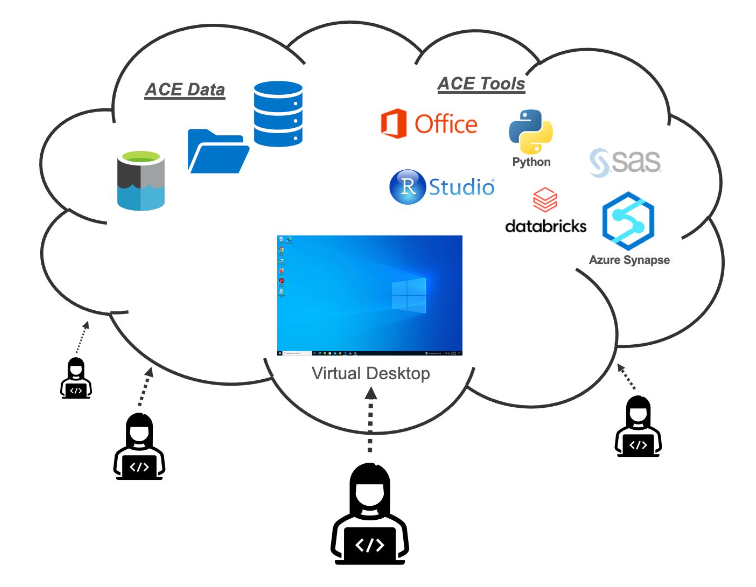The Analytics Cloud Environment (ACE) is a secure, collaborative platform IDOH has deployed to help streamline data-driven practices at the agency. At its most basic, ACE it is a secure place to store and work on data with IDOH team members.
ACE will be accessed through a virtual desktop via your browser or as an icon on your computer, where users can access and use data securely.
- Analytics (why)
- Create data products: data files, analyses, reports, dashboards
- Cloud (where)
- It's virtual and you can access it remotely
- Others can connect to it, too
- Secured
- Environment (what)
- Computing power
- Software
- Data
- How does ACE compare to SSE?
IDOH is committed to preventing leaks of sensitive data, including PII and PHI. An important part of this effort is to move the storage and analysis of sensitive data from individual user workstations to secure cloud environments. SSE (Secure Server Environment) is used to host source systems with sensitive data, while ACE (Analytics Cloud Environment) is meant for analyzing data. Both are secure. Contact Katelyn Worrall (kworrall@health.in.gov) for more information.
- How can I request a new ACE account?
If you don’t already have an account, please contact your team lead or manager to request one. They can contact IDOHODADataEngineers@health.in.gov or Tyler Wong (twong@resultant.com).
- How do I get access to an ACE project?
Please contact your team lead or manager to request access to a project. An ACE administrator can assign you to a specific project that you are approved to access. They can also create new projects if required.
- Does each dataset require its own ACE project, or can we create multiple data products from multiple datasets using the same ACE project?
IDOH requires a project charter to create a project in ACE, and the charter should specify the datasets and their allowable uses. If you want to add data or use it in a way that is outside the charter (within reason), then the project charter should be amended, or a new charter and new ACE project should be created.
- Can I connect to multiple projects at once in ACE?
Most ACE users will have access to one project at a time and will need to switch projects to get data from different projects (e.g. Vital Records and NBS). This is necessary to help keep data compartmentalized and more secure. IDOH leadership (Bob Davis and Peter Krombach) may approve multiple-project-at-once access for some users, depending on their role and applicable IDOH policy.
- Can I access shared drives (e.g. the K Drive) from ACE?
- Where will data in shared drives (e.g. the K Drive) ultimately live? How do we best connect to them?
- What software/tools are available in ACE?
Refer to the Tools and Utilities section in the ACE wiki. Developers (data engineers) may have access to additional tools within the Azure Portal using their elevated/Peoplesoft ID to login.
- How do I request new software be added to the Software Center so I can install it on my virtual desktop?
The request process is initiated by opening a ticket in DevOps. Refer to the VDI Software Requests page in the ACE wiki for more info. For additional support, contact IDOHODADataEngineers@health.in.gov.
- How is Synapse used in ACE?
Synapse is a secure database containing prepared IDOH data that can be used for analysis. You can connect to it from your ACE virtual desktop and create SQL queries to get data from schemas to which you have been granted access. Refer to the Synapse Data Warehouse section of the ACE wiki for more information.
- How can scripts/jobs be automated in ACE?
The primary tools used by ODA data engineers to automate jobs are Azure Data Factory (ADF) and Azure Logic Apps. Databricks does have some job scheduling capabilities, but it is
recommended to schedule Databricks notebooks via ADF instead. It is not possible to schedule jobs that run directly on your virtual desktop or in Jupyterhub, because they are not running 24/7 and there isn't a mechanism to start them automatically as part of a pipeline. - My virtual desktop is slow, or I need a lot of memory to analyze a big data set—can you help me?
Thanks to the scalable nature of the cloud, it’s possible to seamlessly change the size of your virtual desktop. If approved, an administrator can give you more processing power or memory.
- Why does my virtual desktop automatically shut down, and can I prevent it?
It costs money to keep your virtual desktop running, and it’s natural that you may forget to “turn it off” sometimes. To help conserve costs, IDOH has a policy to automatically shut down your virtual desktop at a specific time each day. You can select this time in the ACE user portal. You can also defer the shutdown to the next day or prevent it from ever shutting off.

